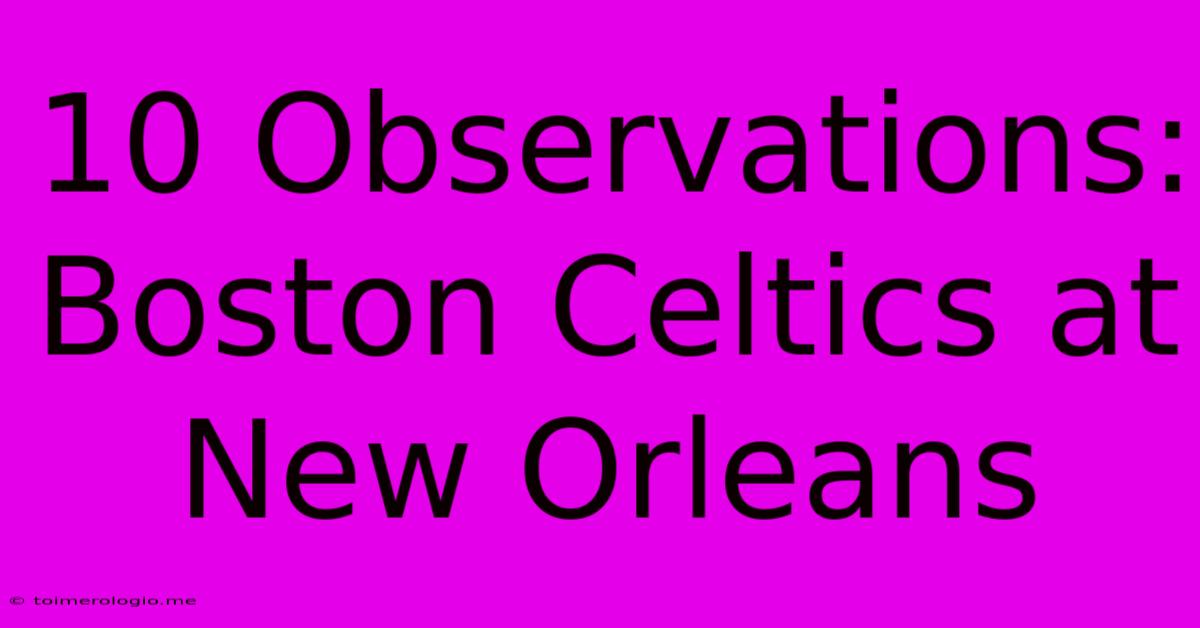10 Observations: Boston Celtics At New Orleans

Discover more detailed and exciting information on our website. Click the link below to start your adventure: Visit Best Website toimerologio.me. Don't miss out!
Table of Contents
10 Observations: Boston Celtics at New Orleans
The Boston Celtics' recent matchup against the New Orleans Pelicans offered a fascinating glimpse into both teams' strengths and weaknesses. While the final score might tell one story, a deeper dive reveals a multitude of tactical battles, individual performances, and strategic decisions that shaped the game's outcome. Here are 10 key observations from this intriguing contest:
1. Jayson Tatum's Scoring Prowess Remains Undisputed
Jayson Tatum continued his stellar season, showcasing his all-around scoring ability. He effortlessly attacked the basket, drained crucial mid-range jumpers, and showcased his improved three-point shooting. His ability to create his own shot, even against tight defense, is a significant asset for the Celtics. Tatum's efficiency, however, remains an area for potential improvement. While the points came, minimizing inefficient possessions will be key in crucial playoff matchups.
2. Zion Williamson's Dominant Interior Presence
Zion Williamson's impact on the game was undeniable. His sheer power and explosiveness near the basket proved incredibly difficult for the Celtics to contain. He consistently overpowered defenders, securing offensive rebounds and finishing through contact. The Pelicans' offensive scheme effectively utilized Zion's strengths, feeding him the ball in advantageous post positions. The Celtics' defensive strategy against him needs further refinement.
3. The Importance of Defensive Rebounding
The game highlighted the critical importance of defensive rebounding. Both teams struggled at times, leading to second-chance opportunities for the opposition. The team that consistently secured defensive boards held a significant advantage in controlling possessions and dictating the pace of the game. This aspect deserves intense focus in future practice sessions for both squads.
4. Three-Point Shooting Fluctuations
Three-point shooting was a volatile factor in the game. Both the Celtics and Pelicans experienced stretches of hot and cold shooting from beyond the arc. The team that could maintain consistency from three-point range had a clear edge in extending leads or mounting comebacks. The impact of three-point shooting on momentum cannot be overstated.
5. The Pelicans' Bench Production
The Pelicans' bench players made significant contributions, providing crucial scoring and energy. This depth proved invaluable in keeping the game competitive throughout. Their bench's ability to match the Celtics' second unit was a key reason why New Orleans stayed in contention. Developing a consistent bench performance will be vital for their playoff aspirations.
6. Celtics' Offensive Flow and Ball Movement
The Celtics' offensive efficiency fluctuated throughout the game. At times, their ball movement was crisp and resulted in high-percentage shots. However, there were stretches where possessions became stagnant, leading to forced shots and turnovers. Improving the consistency of their offensive flow and ball movement is paramount.
7. Defensive Rotations and Communication
Both teams faced challenges with defensive rotations and communication. There were instances where players were slow to react to cuts or screens, leaving open shooters or allowing easy drives to the basket. Improved defensive coordination and communication are crucial areas that require immediate attention.
8. Free Throw Shooting Percentage
Free throw shooting proved to be a deciding factor. The team that maintained a higher free throw percentage held an advantage in accumulating points and securing a comfortable lead. Both teams showed inconsistencies from the charity stripe, suggesting a need for improved practice and focus. Consistent free throw shooting is a critical aspect of winning basketball games.
9. Impact of Turnovers
Turnovers played a pivotal role in shaping the game's momentum. The team that limited turnovers and capitalized on opponent turnovers gained a significant advantage. The importance of protecting the ball and forcing turnovers cannot be underestimated. Reducing turnovers is essential for both the Celtics and Pelicans.
10. Coaching Adjustments and Strategic Decisions
Both coaching staffs made strategic adjustments throughout the game. Their decisions regarding player rotations, offensive and defensive schemes, and timeouts significantly influenced the flow and outcome of the contest. The ability to make timely and effective adjustments is crucial for success in high-stakes matchups. Analyzing these in-game decisions will provide valuable insights for future strategies.
Conclusion:
The Boston Celtics versus New Orleans Pelicans game wasn't just a contest; it was a microcosm of the NBA's competitive landscape. Both teams showcased their strengths and weaknesses, highlighting areas for improvement and offering valuable lessons for future games. The observations above emphasize the need for consistent effort in key areas like rebounding, three-point shooting, and defensive execution. The battle between Tatum and Williamson was captivating, and the supporting casts of each team played their part in a closely fought and enthralling game. The analysis of this game provides significant insight into the dynamics of two ambitious teams vying for success in a fiercely competitive league. Further detailed game analysis, player statistics, and post-game commentary would provide an even richer understanding of the strategies and performance of both the Celtics and the Pelicans.

Thank you for visiting our website wich cover about 10 Observations: Boston Celtics At New Orleans. We hope the information provided has been useful to you. Feel free to contact us if you have any questions or need further assistance. See you next time and dont miss to bookmark.
Also read the following articles
| Article Title | Date |
|---|---|
| Senior Bowl 2025 Live Tv And Online | Feb 02, 2025 |
| La Liga Espanyol Vs Real Madrid Score And Highlights | Feb 02, 2025 |
| 2025 Senior Bowl Game Tv Details | Feb 02, 2025 |
| Tatums Shot Secures Celtics Victory | Feb 02, 2025 |
| Can Ainge Help Celtics Needs | Feb 02, 2025 |
